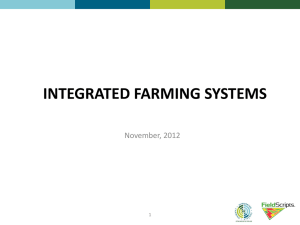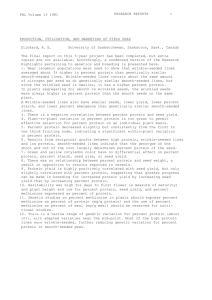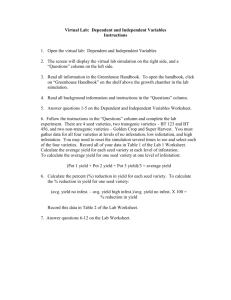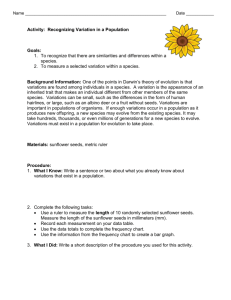Determination of the Relationships between Oil Content and
advertisement
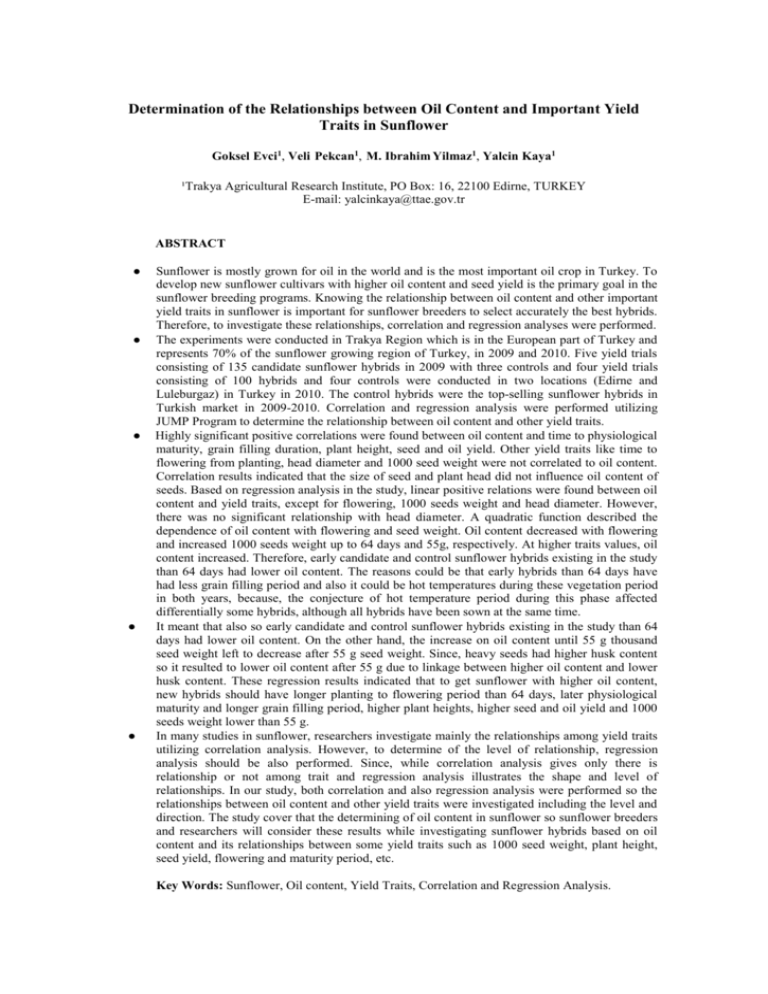
Determination of the Relationships between Oil Content and Important Yield Traits in Sunflower Goksel Evci1, Veli Pekcan1, M. Ibrahim Yilmaz1, Yalcin Kaya1 ¹Trakya Agricultural Research Institute, PO Box: 16, 22100 Edirne, TURKEY E-mail: yalcinkaya@ttae.gov.tr ABSTRACT ● ● ● ● ● Sunflower is mostly grown for oil in the world and is the most important oil crop in Turkey. To develop new sunflower cultivars with higher oil content and seed yield is the primary goal in the sunflower breeding programs. Knowing the relationship between oil content and other important yield traits in sunflower is important for sunflower breeders to select accurately the best hybrids. Therefore, to investigate these relationships, correlation and regression analyses were performed. The experiments were conducted in Trakya Region which is in the European part of Turkey and represents 70% of the sunflower growing region of Turkey, in 2009 and 2010. Five yield trials consisting of 135 candidate sunflower hybrids in 2009 with three controls and four yield trials consisting of 100 hybrids and four controls were conducted in two locations (Edirne and Luleburgaz) in Turkey in 2010. The control hybrids were the top-selling sunflower hybrids in Turkish market in 2009-2010. Correlation and regression analysis were performed utilizing JUMP Program to determine the relationship between oil content and other yield traits. Highly significant positive correlations were found between oil content and time to physiological maturity, grain filling duration, plant height, seed and oil yield. Other yield traits like time to flowering from planting, head diameter and 1000 seed weight were not correlated to oil content. Correlation results indicated that the size of seed and plant head did not influence oil content of seeds. Based on regression analysis in the study, linear positive relations were found between oil content and yield traits, except for flowering, 1000 seeds weight and head diameter. However, there was no significant relationship with head diameter. A quadratic function described the dependence of oil content with flowering and seed weight. Oil content decreased with flowering and increased 1000 seeds weight up to 64 days and 55g, respectively. At higher traits values, oil content increased. Therefore, early candidate and control sunflower hybrids existing in the study than 64 days had lower oil content. The reasons could be that early hybrids than 64 days have had less grain filling period and also it could be hot temperatures during these vegetation period in both years, because, the conjecture of hot temperature period during this phase affected differentially some hybrids, although all hybrids have been sown at the same time. It meant that also so early candidate and control sunflower hybrids existing in the study than 64 days had lower oil content. On the other hand, the increase on oil content until 55 g thousand seed weight left to decrease after 55 g seed weight. Since, heavy seeds had higher husk content so it resulted to lower oil content after 55 g due to linkage between higher oil content and lower husk content. These regression results indicated that to get sunflower with higher oil content, new hybrids should have longer planting to flowering period than 64 days, later physiological maturity and longer grain filling period, higher plant heights, higher seed and oil yield and 1000 seeds weight lower than 55 g. In many studies in sunflower, researchers investigate mainly the relationships among yield traits utilizing correlation analysis. However, to determine of the level of relationship, regression analysis should be also performed. Since, while correlation analysis gives only there is relationship or not among trait and regression analysis illustrates the shape and level of relationships. In our study, both correlation and also regression analysis were performed so the relationships between oil content and other yield traits were investigated including the level and direction. The study cover that the determining of oil content in sunflower so sunflower breeders and researchers will consider these results while investigating sunflower hybrids based on oil content and its relationships between some yield traits such as 1000 seed weight, plant height, seed yield, flowering and maturity period, etc. Key Words: Sunflower, Oil content, Yield Traits, Correlation and Regression Analysis. INTRODUCTION Sunflower is one of the important oil crops in the world and it is mainly growing for oil. Turkish consumers mostly prefer sunflower oil for vegetable oil and it is mostly consuming for frying oil. On the other hand, Trakya Birlik which is a farmer cooperative buying and crushing 40% of domestic sunflower production started to buy sunflower seeds based on oil content recently with giving extra premium. Therefore, higher oil yielding hybrids having higher oil content are preferred more by sunflower in recent years in Turkey. Oil content is one of the important yield traits in sunflower. It is qualitative trait but it is also influenced from environmental factors in some years especially in dry conditions during grain filling period. Breeders focus on the main attention to develop sunflower genotypes with higher seed and oil yield performance so researchers investigated both the effect of environmental factors on seed and oil yield and also the relationships among yield traits including oil content mostly utilizing from correlation and path analysis which gives only there is relationship or not among trait. In these studies, strong relationships between oil content and other important yield traits were determined in sunflower (Kaya et al. 2006, 2008; Goksoy and Turan, 2007; Gontcharov and Zaharova 2008; Mijic et al. 2009; Anandhan et al., 2010, Sowmya et al., 2010, Hladni et al., 2011; Tyagi 2011; Ghaffari et al., 2011). On the other hand, regression analysis describes also the level of the relationship among yield components as differing than correlation and path analysis which explicate yield relationships only. Utilizing from regression analysis, the researchers investigated the relationships between seed yield and yield traits (Kaya et al., (2006, 2007, 2009a); and oil yield and other yield traits (Kaya et al., 2009b) in sunflower. However, the relationships between oil content and other yield characteristics utilizing regression analysis are never performed until today. Therefore, the study covering both correlation and regression analysis illustrated the shape and level of relationship was conducted to determine the relationships between oil content and other important yield traits in sunflower to contribute the knowledge of breeders to develop new cultivars which are higher oil content and oil yield performance. MATERIALS AND METHODS The experiments as part of Turkish National Sunflower Research Project carrying out by Trakya Agricultural Research Institute, Edirne, Turkey, were conducted in Trakya Region in 2009 and 2010. The region is in the European part of Turkey and represents 70% of the sunflower growing region of Turkey so research results reveal accurately on sunflower conditions in Turkey and also Black Sea Region which has % 34 of the sunflower planted area and % 50 of the production of the world. Five yield trials consisting of 135 candidate sunflower hybrids in 2009 with three controls and four yield trials consisting of 100 hybrids and four controls were conducted in two locations (Edirne and Luleburgaz) in Turkey in 2010. The control hybrids were the top-selling sunflower hybrids in Turkish market in 2009-2010. The experimental design was a Randomized Complete Block Design with four replicates. The four rows plots were 6-m long with the 70 x 35-cm plant spacing. The middle 2 rows were harvested and the border rows were discarded, and plot size was 7.56 m² at harvest. Seed and oil yield (kg ha-1), 1000 seed weight (g), flowering and physiological maturity period (days), seed filling period (days between flowering to physiological maturity), plant height (cm), oil content (%) were measured. Correlation and regression analysis were performed utilizing JUMP Program to determine the relationship between oil content and other yield traits. RESULTS Highly significant positive correlations were observed between oil content and time to physiological maturity, grain filling period, plant height, seed and oil yield except time to flowering from planting, head diameter and 1000 seed weight in the study (Table 1). Correlation results indicated that the size of seed and plant head did not influence oil content of seeds in sunflower. Similarly, oil content was not correlated with flowering time due to oil determination in sunflower formed after flowering time. However, oil and seed yield of hybrids was correlated with all yield traits examined in the research. Oil content of hybrids were changed between 32,5-53,5% and their average was 43,6%, flowering time of hybrids ranged between 54-76 days, physiological maturity period as 90-122 days, grain filling period as 25-52 days, plant height 106-236 cm, head diameter 10-30 cm, 1000 seed weight 28,6-92,6 g, seed yield 1555-4245 kg ha-1 and oil yield as 641-1991 kg ha-1 in the study (Table 2). Based on regression analysis, highly significant relationships were determined almost all traits except head diameter (Table 2). On the other hand, linear positive relations were found between oil content and plant height, seed and oil yield, physiological maturity and seed filling period (Figure 2, 3, 4, 5 and 6). However, quadratic relationships were determined only between oil content and flowering time and also 1000 seeds weight (Figure 1 and 7). However, there was no significant relationship with head diameter in the study. Table 1: Correlation values among traits of sunflower hybrids tested. Oil Flowering Phy Grain Content Time Maturity Filling Oil Content 1,000 Flow. Time 0,035ns 1,000 Phy Maturity 0,142** 0,607** 1,000 Grain Filling 0,149** -0,076ns 0,747** 1,000 Plant Height 0,377** 0,060ns 0,349** 0,387** Hd Diameter 0,010ns -0,149** 0,238** 0,423** Seed Yield 0,369** 0,158** 0,372** 0,334** Oil Yield 0,656** 0,157** 0,368** 0,331** Th S Weight -0,085ns -0,121* 0,330** 0,515** *P < 0.05, **P < 0.01, ns= Non Significant Plant Head Height Diameter 1,000 0,437** 0,608** 0,620** 0,246** Seed Yield Oil Yield 1,000 0,296** 1,000 0,243** 0,941** 1,000 0,472** 0,267** 0,191** Tho. S Weight 1,000 Table 2. Regression coefficients between seed yield and yield components. Yield Components Avg Std Dv Range R² DF F Ratio P Level b0 b1 Flowering Time 64,9 3,9 54-76 0,02 518 5,34 0,005 39,78 0,05 0,02 Physiological Maturity 104,9 5,6 90-122 0,02 490 11,33 0,001 33,41 0,10 - Grain Filling 40,3 25-52 0,02 490 10,98 0,001 38,78 0,12 - Plant Height 143,9 18,0 106-236 0,13 518 74,98 0,001 33,48 0,07 - Seed Yield 251,5 47,2 1555-4245 0,14 518 85,45 0,001 36,45 0,03 - Oil Yield 110,3 25,8 641-1991 0,42 518 381,03 0,001 33,67 0,09 - 1000 Seed Weight 54,3 0,03 459 7,74 44,78 0,01 0,01 4,5 10,5 28,6-92,6 0,001 b2 R² = The determination coefficient, b0, b1 and b2 = Regression coefficients, DF = Degree of Freedom. Oil Content (%) 50 Y = 39,78 + 0,05X + 0,02X2 40 60 70 Flowering Time (days) Figure 1. The relationship between oil content and flowering period. Oil Content (%) 50 Y = 33,42 + 0,10X 40 90 95 100 105 110 115 120 Physiological Maturity (days) Figure 2. The relationship between oil content and physiological maturity period. Oil Content (%) 50 Y = 38,76 + 0,12X 40 30 40 50 Grain Filling Period (days) Figure 3. The relationship between oil content and grain filling period. Y = 33,48 + 0,07X Oil Content (%) 50 40 100 120 140 160 180 200 Plant Height (cm) Figure 4. The relationship between oil content and plant height. 220 240 Oil Content (%) 50 Y = 36,45 + 0,03X 40 200 300 Seed Yield (kg /da) 400 Figure 5. The relationship between oil content and seed yield. Oil Content (%) 50 Y = 33,68 + 0,09X 40 60 80 100 120 140 160 Oil Yield Kg/da) 180 200 Figure 6. The relationship between oil content and oil yield. Y = 44,78 + 0,01X + 0,01X2 Oil Content (%) 50 40 30 40 50 60 70 80 1000 Seed Weight (g) Figure 7. The relationship between oil content and 100 seed weight. 90 A quadratic relationship was observed the dependence of oil content with flowering time. Oil content decreased with flowering up to 64 days, because of that early candidate and control sunflower hybrids existing in the study than 64 days had lower oil content (Figure 1). The reasons could be that early hybrids than 64 days have had less grain filling period and also it could be hot temperatures during these vegetation period in both years. It also meant that so early candidate and control sunflower hybrids existing in the study than 64 days had lower oil content. In physiological and grain filling period, linear relationships were observed so while oil content of hybrids were increasing with the longer maturation period (Figure 2 and 3). Similarly, the linear relationships were determined in oil content with both seed and also oil yield in the study (Figure 5 and 6). On the other hand, plant height also related linearly with oil content in positive way too (Figure 4). In the relationship with thousand seed weight; the increase on oil content until 55 g thousand seed weight left to decrease after 55 g seed weight. At higher traits values, oil content decreased. Since, heavy seeds had higher husk content so it resulted to lower oil content after 55 g due to linkage between higher oil content and lower husk content (Figure 7). DISCUSSION Researchers investigated the relationships among yield traits only utilizing correlation and path analysis in many studies. Similar correlation results were obtained in our study like almost all studies mentioned above. Our study covered both correlation and also regression analysis to determine oil content in all detail so sunflower breeders could consider these results while investigating sunflower hybrids based on the relationships between oil content and important yield traits. As a conclusion; the results of our study indicated that to get sunflower with higher oil content, new hybrids should have longer planting to flowering period than 64 days, later physiological maturity and longer grain filling period, higher plant heights, higher seed and oil yield and 1000 seeds weight lower than 55 g. However, further research should be performed to generalize the results which covering longer years and many locations. REFERENCES Anandhan, T., N. Manivannan, P. Vindhiyavarman and P. Jeyakumar. 2010. Correlation for oil yield in sunflower (Helianthus annus.L). Electronic Journal of Plant Breeding, 1(4): 869-871 Ghaffari, M., I. Farrokhi, and M. Mirzapour. 2011. Combining ability and gene action for agronomic traits and oil content in sunflower (H. annuus L.) using F1 hybrids. Crop Breeding Journal, 1(1): 75-87. Gontcharov, S. and M. Zaharova. 2008. Vegetation period of hybrid sunflower productivity in breeding for earliness. p. 531-533. Proceeding of 17th International Sunflower Conference. Cordoba, Spain, Goksoy, A. T. and Z. M. Turan. 2007. Correlations and path analysis of yield components in synthetic varieties of sunflower (Helianthus annuus L.) Acta Agronomica Hungarica, 10: 339-345. Hladni N., Škorić D., Kraljević-Balalić M., Jocić S., Dušanić, N. 2011. Line x tester analysis for yield components in sunflower and their correlations with seed yield (H. annuus L.). Genetika. 43 (2): 297-306. Kaya, Y., G. Evci, S. Durak, V. Pekcan, and T. Gucer. 2006. The Determining the Relationships between Seed Yield and Other Yield Components in Sunflower (H. annuus L.) in Different Environmental Conditons. Trakya Univ. J. Sci, 7(1): 37-44. Kaya Y., G. Evci, S. Durak, V. Pekcan and T. Gücer. 2007. Determining the relationships between yield and yield attributes in sunflower. Turkish. Journal of Agricultural and Forestry 31: 237-244. Kaya, Y., G. Evci, V. Pekcan, T. Gucer, S. Durak and I. M.Yilmaz. 2008. The Path Analysis of yield traits in sunflower (Helianthus annuus L). Latvian Journal of Agronomy. 72-77. Kaya, Y., G. Evci, S. Durak, V. Pekcan, and T. Gücer. 2009a. Yield components affecting seed yield and their relationships in sunflower (Helianthus annuus L.). Pakistan Journal of Botany. 41(5): 2261-2269. Kaya, Y., G. Evci, V. Pekcan, T. Gücer, and I. M. Yilmaz. 2009b. Determination of Relationships Between Oil Yield and Some Yield Traits in Sunflower. Ankara Univ. J. of Agric. Sci. 15 (4): 310-318. Mijic, A., I. Liovic, Z. Zdunic, S. Maric, A. M. Jeromela, and M. Jankulovska. 2009. Quantitative analysis of oil yield and its components in sunflower (H. annuus L.). Romanian Agric. Res., 26: 41-4. Sowmya, H. C., Y. G. Shadakshari, K. J., Pranesh, A. Srivastava and B. Nandini. 2010. Character association and path analysis in sunflower (H. annuus L.). Electronic J. Plant Breeding, 1(4): 828-831. Tyagi, S. D. 2011. An analysis of the association factors influencing seed yield and oil percentage in sunflower (Helianthus annuus L.). Progressive Agriculture, 11 (1): 149-155.


